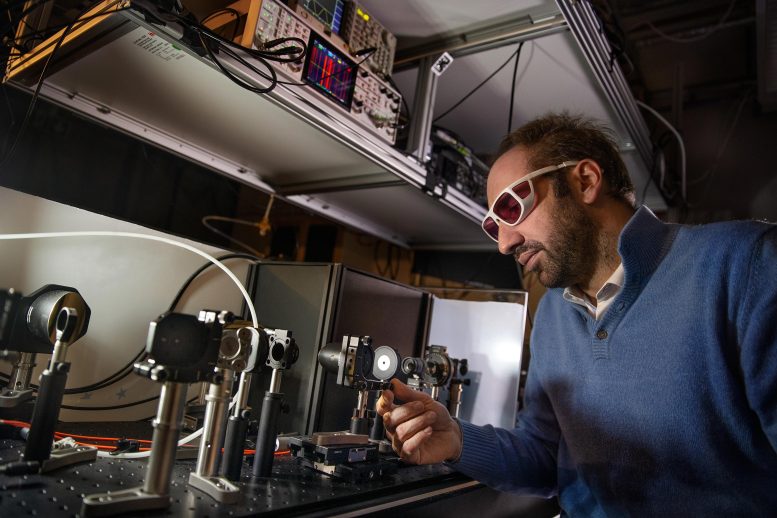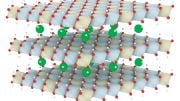
An international research collaboration has pioneered inducing magnetism in non-magnetic materials at room temperature using laser light, potentially revolutionizing information technology and material science. Credit: SciTechDaily.com
The potential of quantum technology is huge but is today largely limited to the extremely cold environments of laboratories. Now, researchers at Stockholm University, at the Nordic Institute for Theoretical Physics and at the Ca’ Foscari University of Venice have succeeded in demonstrating for the very first time how laser light can induce quantum behavior at room temperature – and make non-magnetic materials magnetic. The breakthrough is expected to pave the way for faster and more energy-efficient computers, information transfer, and data storage.
Within a few decades, the advancement of quantum technology is expected to revolutionize several of society’s most important areas and pave the way for completely new technological possibilities in communication and energy. Of particular interest for researchers in the field are the peculiar and bizarre properties of quantum particles – which deviate completely from the laws of classical physics and can make materials magnetic or superconducting. By increasing the understanding of exactly how and why this type of quantum states arise, the goal is to be able to control and manipulate materials to obtain quantum mechanical properties.
So far, researchers have only been able to induce quantum behaviors, such as magnetism and superconductivity, at extremely cold temperatures. Therefore, the potential of quantum research is still limited to laboratory environments.

Stefano Bonetti in his lab at Stockholm University. Credit: Knut and Alice Wallenbergs Foundation/Magnus Bergström
Breakthrough in Room Temperature Quantum Effects
Now, a research team from Stockholm University and the Nordic Institute of Theoretical Physics (NORDITA)* in Sweden, the University of Connecticut and the SLAC National Accelerator Laboratory in USA, the National Institute for Materials Science in Tsukuba, Japan, the Elettra-Sincrotrone Trieste, the ‘Sapienza’ University of Rome and the Ca’ Foscari University of Venice in Italy, is the first in the world to demonstrate in an experiment how laser light can induce magnetism in a non-magnetic material at room temperature. In the study, published in the scientific journal Nature, the researchers subjected the quantum material strontium titanate to short but intense laser beams of a peculiar wavelength and polarization, to induced magnetism.
New Approaches to Material Manipulation
“The innovation in this method lies in the concept of letting light move atoms and electrons in this material in circular motion, so to generate currents that make it as magnetic as a refrigerator magnet. We have been able to do so by developing a new light source in the far-infrared with a polarization that has a “corkscrew” shape. This is the first time we have been able to induce and clearly see how the material becomes magnetic at room temperature in an experiment. Furthermore, our approach allows to make magnetic materials out of many insulators, when magnets are typically made of metals. In the long run, this opens for completely new applications in society,” says the research leader Stefano Bonetti at Stockholm University and at the Ca’ Foscari University of Venice.
Practical Applications and Future Implications
The method is based on the theory of “dynamic multiferroicity,” which predicts that when titanium atoms are “stirred up” with circularly polarized light in an oxide based on titanium and strontium, a magnetic field will be formed. But it is only now that the theory can be confirmed in practice. The breakthrough is expected to have broad applications in several information technologies.
“This opens up for ultra-fast magnetic switches that can be used for faster information transfer and considerably better data storage, and for computers that are significantly faster and more energy-efficient,” says Alexander Balatsky, professor of physics at NORDITA.
In fact, the results of the team have already been reproduced in several other labs, and a publication in the same issue of Nature demonstrates that this approach can be used to write, and hence store, magnetic information. A new chapter in designing new materials using light has been opened.
Reference: “Terahertz electric-field-driven dynamical multiferroicity in SrTiO3” by M. Basini, M. Pancaldi, B. Wehinger, M. Udina, V. Unikandanunni, T. Tadano, M. C. Hoffmann, A. V. Balatsky and S. Bonetti, 10 April 2024, Nature.
DOI: 10.1038/s41586-024-07175-9









It’s a eureka moment for me, since in 2004 when first bought a laser pointer, I had an idea of using a laser beam to turn a special material into a magnet, which in turn generate electricity in a coil winding around it. By switching the laser beam on-off at a high frequency, thus we can generate an AC current, and we can unlock a new source of energy from magnetism.
If you can turn a laser on and off at high frequency, why not use that switch to control your electrical current instead of requiring extra steps of a laser and magnet?
My intention was that we use low power laser to turn a particular material into a strong magnet, rather than using an electromagnetic fashion that only has unity gain.